BUSM4176 Reflective Report: Management Theory & Application
VerifiedAdded on 2023/06/07
|6
|1456
|445
Report
AI Summary
This report reflects on effective management practices within organizations, drawing from the author's experience at Adfinder, an online marketing company. Key aspects discussed include the importance of training, vision, employee engagement, and efficiency in managing a workforce. The report addresses strategies for dealing with underperforming employees, managing ethical dilemmas related to cultural diversity, and the application of Henri Fayol's management principles. It emphasizes the significance of communication, motivation, and ethical behavior in fostering a successful workplace. The report also references relevant management theories and research, providing a comprehensive overview of the challenges and strategies involved in effective management.
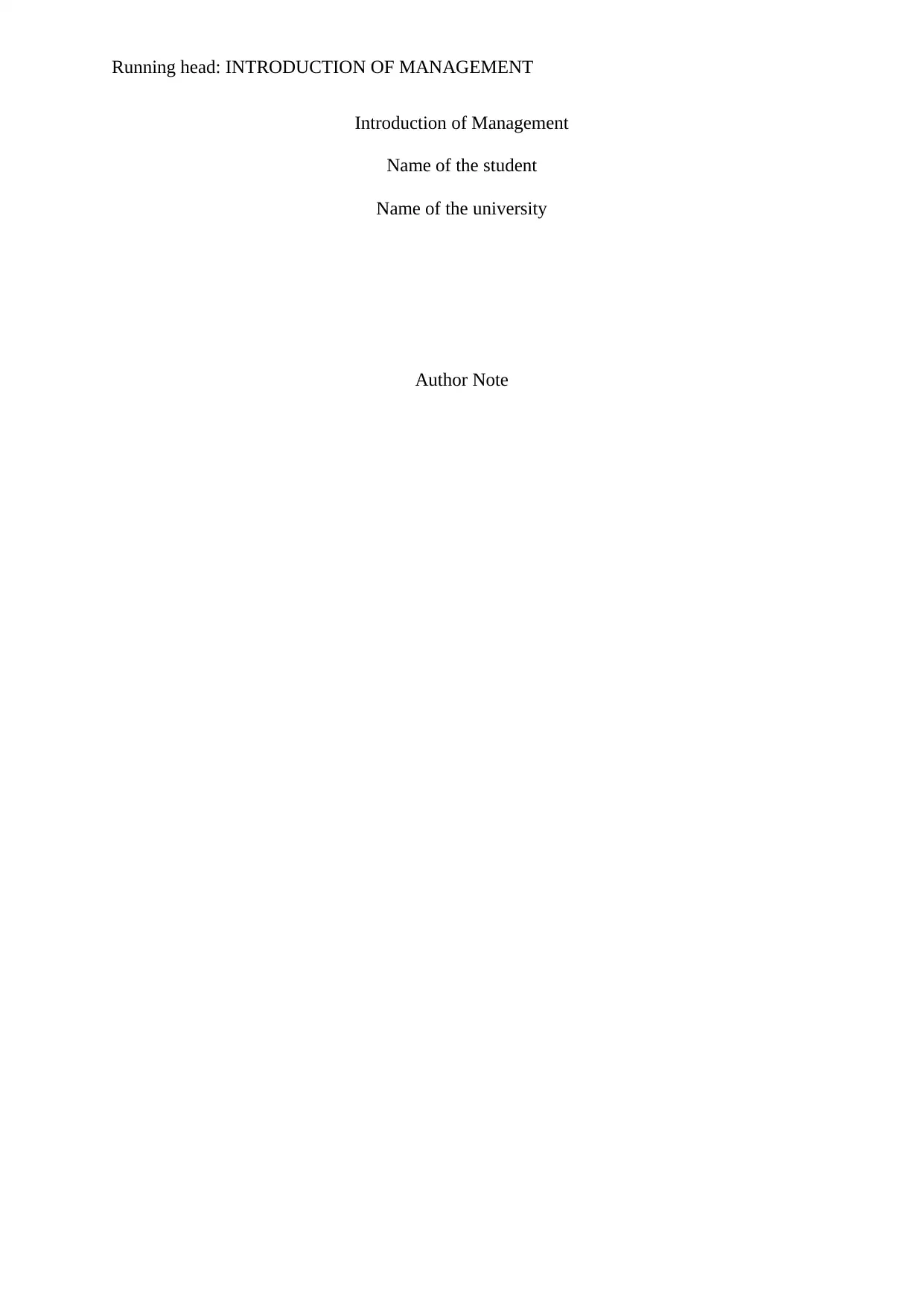
Running head: INTRODUCTION OF MANAGEMENT
Introduction of Management
Name of the student
Name of the university
Author Note
Introduction of Management
Name of the student
Name of the university
Author Note
Secure Best Marks with AI Grader
Need help grading? Try our AI Grader for instant feedback on your assignments.
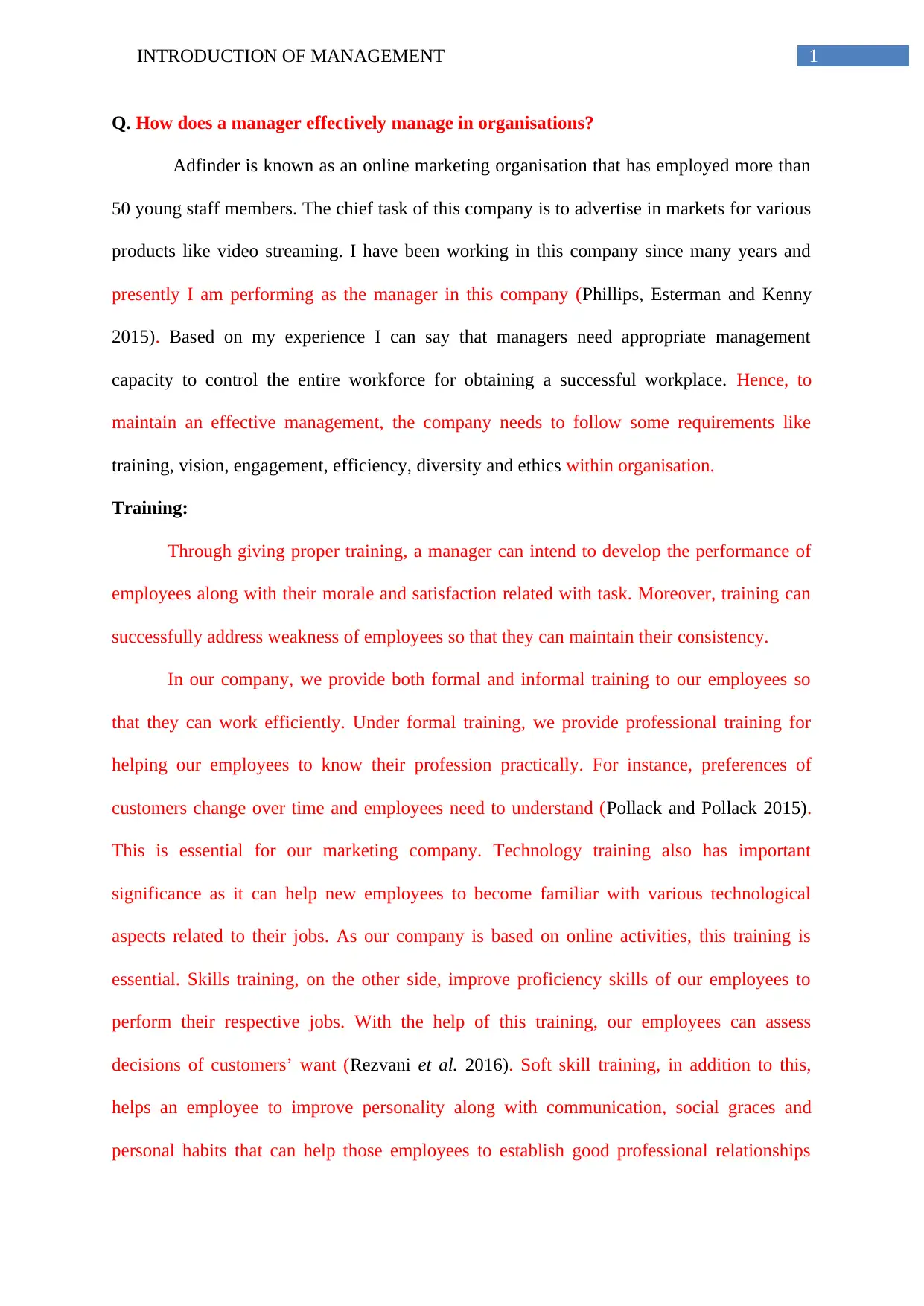
1INTRODUCTION OF MANAGEMENT
Q. How does a manager effectively manage in organisations?
Adfinder is known as an online marketing organisation that has employed more than
50 young staff members. The chief task of this company is to advertise in markets for various
products like video streaming. I have been working in this company since many years and
presently I am performing as the manager in this company (Phillips, Esterman and Kenny
2015). Based on my experience I can say that managers need appropriate management
capacity to control the entire workforce for obtaining a successful workplace. Hence, to
maintain an effective management, the company needs to follow some requirements like
training, vision, engagement, efficiency, diversity and ethics within organisation.
Training:
Through giving proper training, a manager can intend to develop the performance of
employees along with their morale and satisfaction related with task. Moreover, training can
successfully address weakness of employees so that they can maintain their consistency.
In our company, we provide both formal and informal training to our employees so
that they can work efficiently. Under formal training, we provide professional training for
helping our employees to know their profession practically. For instance, preferences of
customers change over time and employees need to understand (Pollack and Pollack 2015).
This is essential for our marketing company. Technology training also has important
significance as it can help new employees to become familiar with various technological
aspects related to their jobs. As our company is based on online activities, this training is
essential. Skills training, on the other side, improve proficiency skills of our employees to
perform their respective jobs. With the help of this training, our employees can assess
decisions of customers’ want (Rezvani et al. 2016). Soft skill training, in addition to this,
helps an employee to improve personality along with communication, social graces and
personal habits that can help those employees to establish good professional relationships
Q. How does a manager effectively manage in organisations?
Adfinder is known as an online marketing organisation that has employed more than
50 young staff members. The chief task of this company is to advertise in markets for various
products like video streaming. I have been working in this company since many years and
presently I am performing as the manager in this company (Phillips, Esterman and Kenny
2015). Based on my experience I can say that managers need appropriate management
capacity to control the entire workforce for obtaining a successful workplace. Hence, to
maintain an effective management, the company needs to follow some requirements like
training, vision, engagement, efficiency, diversity and ethics within organisation.
Training:
Through giving proper training, a manager can intend to develop the performance of
employees along with their morale and satisfaction related with task. Moreover, training can
successfully address weakness of employees so that they can maintain their consistency.
In our company, we provide both formal and informal training to our employees so
that they can work efficiently. Under formal training, we provide professional training for
helping our employees to know their profession practically. For instance, preferences of
customers change over time and employees need to understand (Pollack and Pollack 2015).
This is essential for our marketing company. Technology training also has important
significance as it can help new employees to become familiar with various technological
aspects related to their jobs. As our company is based on online activities, this training is
essential. Skills training, on the other side, improve proficiency skills of our employees to
perform their respective jobs. With the help of this training, our employees can assess
decisions of customers’ want (Rezvani et al. 2016). Soft skill training, in addition to this,
helps an employee to improve personality along with communication, social graces and
personal habits that can help those employees to establish good professional relationships
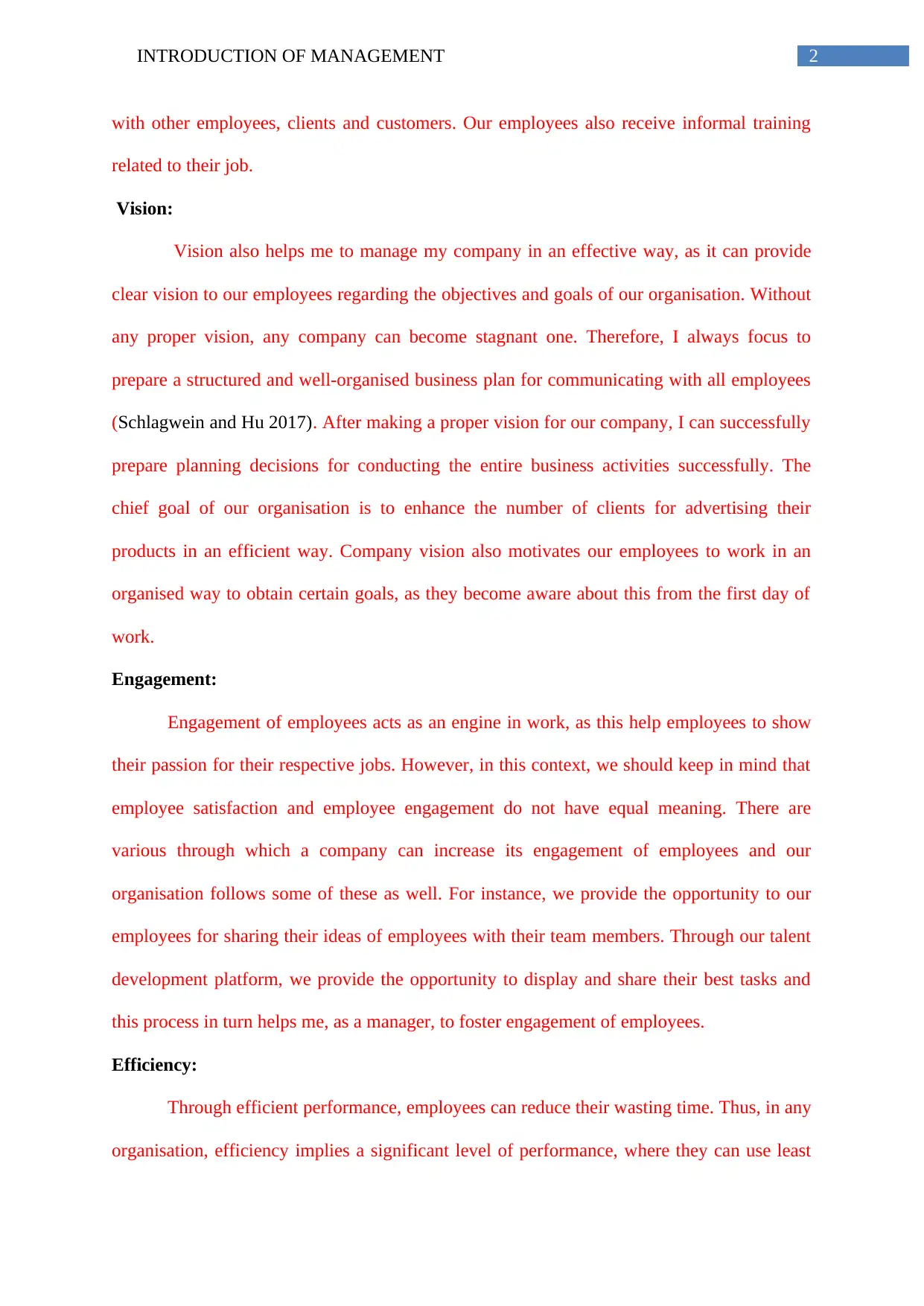
2INTRODUCTION OF MANAGEMENT
with other employees, clients and customers. Our employees also receive informal training
related to their job.
Vision:
Vision also helps me to manage my company in an effective way, as it can provide
clear vision to our employees regarding the objectives and goals of our organisation. Without
any proper vision, any company can become stagnant one. Therefore, I always focus to
prepare a structured and well-organised business plan for communicating with all employees
(Schlagwein and Hu 2017). After making a proper vision for our company, I can successfully
prepare planning decisions for conducting the entire business activities successfully. The
chief goal of our organisation is to enhance the number of clients for advertising their
products in an efficient way. Company vision also motivates our employees to work in an
organised way to obtain certain goals, as they become aware about this from the first day of
work.
Engagement:
Engagement of employees acts as an engine in work, as this help employees to show
their passion for their respective jobs. However, in this context, we should keep in mind that
employee satisfaction and employee engagement do not have equal meaning. There are
various through which a company can increase its engagement of employees and our
organisation follows some of these as well. For instance, we provide the opportunity to our
employees for sharing their ideas of employees with their team members. Through our talent
development platform, we provide the opportunity to display and share their best tasks and
this process in turn helps me, as a manager, to foster engagement of employees.
Efficiency:
Through efficient performance, employees can reduce their wasting time. Thus, in any
organisation, efficiency implies a significant level of performance, where they can use least
with other employees, clients and customers. Our employees also receive informal training
related to their job.
Vision:
Vision also helps me to manage my company in an effective way, as it can provide
clear vision to our employees regarding the objectives and goals of our organisation. Without
any proper vision, any company can become stagnant one. Therefore, I always focus to
prepare a structured and well-organised business plan for communicating with all employees
(Schlagwein and Hu 2017). After making a proper vision for our company, I can successfully
prepare planning decisions for conducting the entire business activities successfully. The
chief goal of our organisation is to enhance the number of clients for advertising their
products in an efficient way. Company vision also motivates our employees to work in an
organised way to obtain certain goals, as they become aware about this from the first day of
work.
Engagement:
Engagement of employees acts as an engine in work, as this help employees to show
their passion for their respective jobs. However, in this context, we should keep in mind that
employee satisfaction and employee engagement do not have equal meaning. There are
various through which a company can increase its engagement of employees and our
organisation follows some of these as well. For instance, we provide the opportunity to our
employees for sharing their ideas of employees with their team members. Through our talent
development platform, we provide the opportunity to display and share their best tasks and
this process in turn helps me, as a manager, to foster engagement of employees.
Efficiency:
Through efficient performance, employees can reduce their wasting time. Thus, in any
organisation, efficiency implies a significant level of performance, where they can use least
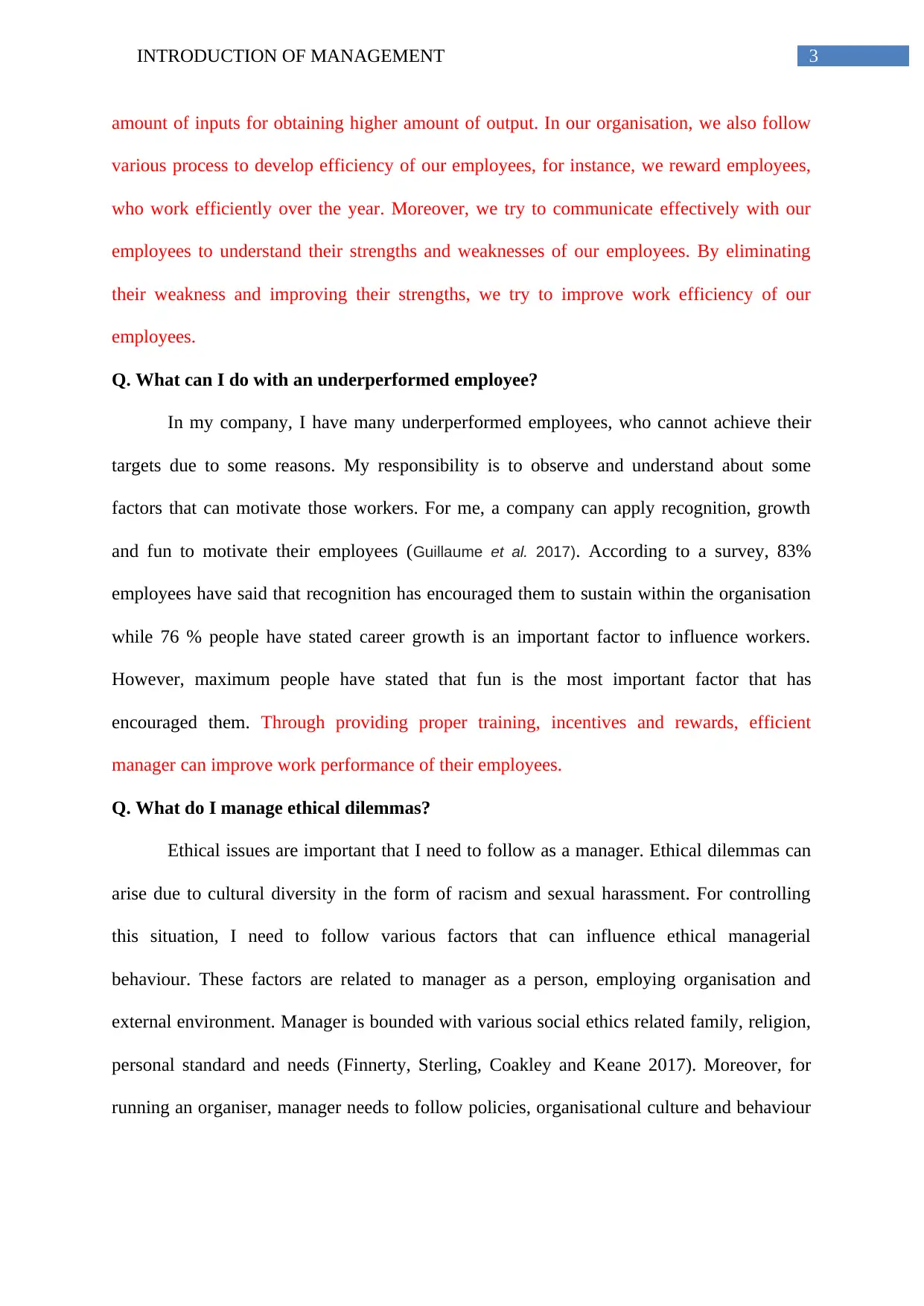
3INTRODUCTION OF MANAGEMENT
amount of inputs for obtaining higher amount of output. In our organisation, we also follow
various process to develop efficiency of our employees, for instance, we reward employees,
who work efficiently over the year. Moreover, we try to communicate effectively with our
employees to understand their strengths and weaknesses of our employees. By eliminating
their weakness and improving their strengths, we try to improve work efficiency of our
employees.
Q. What can I do with an underperformed employee?
In my company, I have many underperformed employees, who cannot achieve their
targets due to some reasons. My responsibility is to observe and understand about some
factors that can motivate those workers. For me, a company can apply recognition, growth
and fun to motivate their employees (Guillaume et al. 2017). According to a survey, 83%
employees have said that recognition has encouraged them to sustain within the organisation
while 76 % people have stated career growth is an important factor to influence workers.
However, maximum people have stated that fun is the most important factor that has
encouraged them. Through providing proper training, incentives and rewards, efficient
manager can improve work performance of their employees.
Q. What do I manage ethical dilemmas?
Ethical issues are important that I need to follow as a manager. Ethical dilemmas can
arise due to cultural diversity in the form of racism and sexual harassment. For controlling
this situation, I need to follow various factors that can influence ethical managerial
behaviour. These factors are related to manager as a person, employing organisation and
external environment. Manager is bounded with various social ethics related family, religion,
personal standard and needs (Finnerty, Sterling, Coakley and Keane 2017). Moreover, for
running an organiser, manager needs to follow policies, organisational culture and behaviour
amount of inputs for obtaining higher amount of output. In our organisation, we also follow
various process to develop efficiency of our employees, for instance, we reward employees,
who work efficiently over the year. Moreover, we try to communicate effectively with our
employees to understand their strengths and weaknesses of our employees. By eliminating
their weakness and improving their strengths, we try to improve work efficiency of our
employees.
Q. What can I do with an underperformed employee?
In my company, I have many underperformed employees, who cannot achieve their
targets due to some reasons. My responsibility is to observe and understand about some
factors that can motivate those workers. For me, a company can apply recognition, growth
and fun to motivate their employees (Guillaume et al. 2017). According to a survey, 83%
employees have said that recognition has encouraged them to sustain within the organisation
while 76 % people have stated career growth is an important factor to influence workers.
However, maximum people have stated that fun is the most important factor that has
encouraged them. Through providing proper training, incentives and rewards, efficient
manager can improve work performance of their employees.
Q. What do I manage ethical dilemmas?
Ethical issues are important that I need to follow as a manager. Ethical dilemmas can
arise due to cultural diversity in the form of racism and sexual harassment. For controlling
this situation, I need to follow various factors that can influence ethical managerial
behaviour. These factors are related to manager as a person, employing organisation and
external environment. Manager is bounded with various social ethics related family, religion,
personal standard and needs (Finnerty, Sterling, Coakley and Keane 2017). Moreover, for
running an organiser, manager needs to follow policies, organisational culture and behaviour
Secure Best Marks with AI Grader
Need help grading? Try our AI Grader for instant feedback on your assignments.
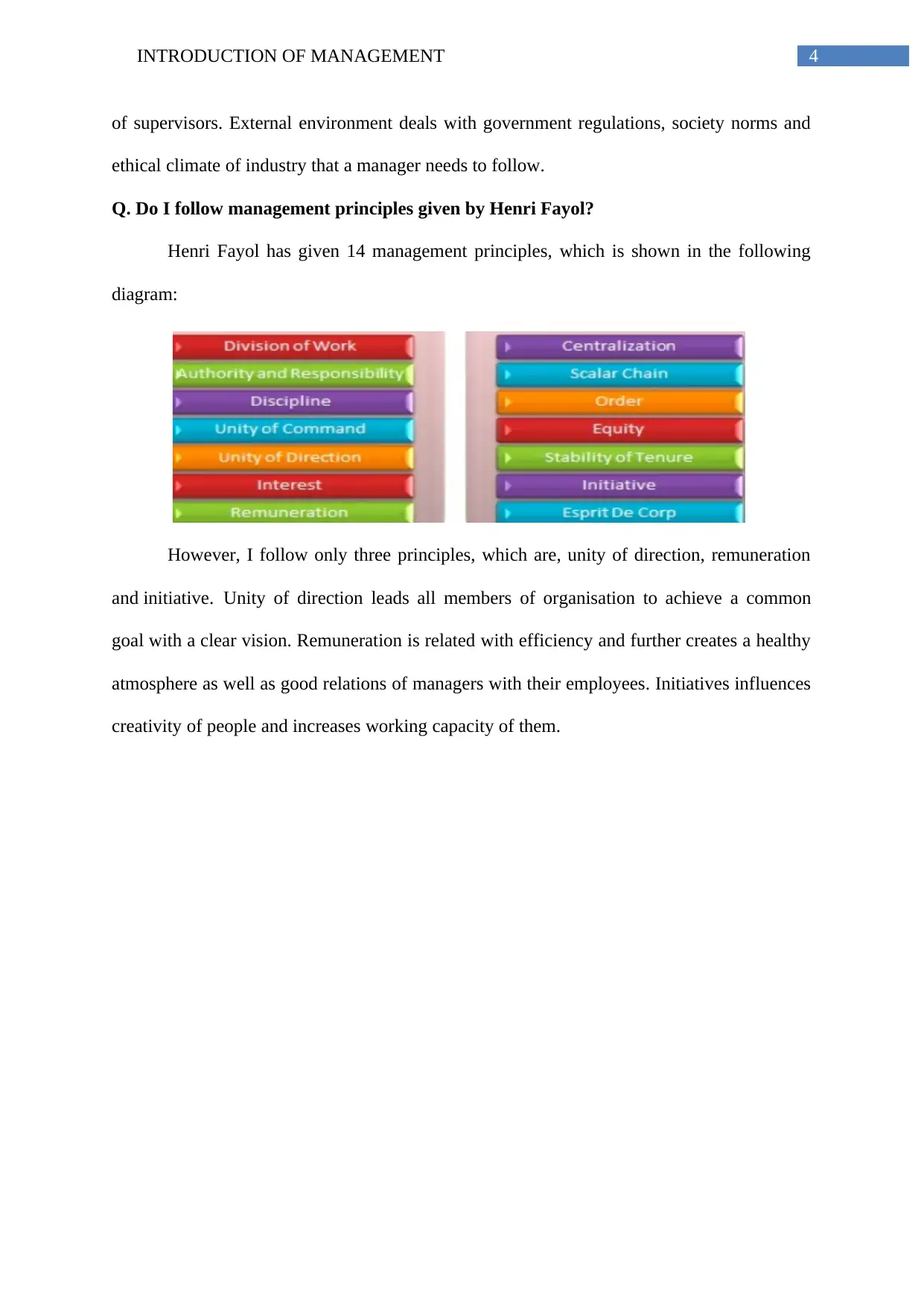
4INTRODUCTION OF MANAGEMENT
of supervisors. External environment deals with government regulations, society norms and
ethical climate of industry that a manager needs to follow.
Q. Do I follow management principles given by Henri Fayol?
Henri Fayol has given 14 management principles, which is shown in the following
diagram:
However, I follow only three principles, which are, unity of direction, remuneration
and initiative. Unity of direction leads all members of organisation to achieve a common
goal with a clear vision. Remuneration is related with efficiency and further creates a healthy
atmosphere as well as good relations of managers with their employees. Initiatives influences
creativity of people and increases working capacity of them.
of supervisors. External environment deals with government regulations, society norms and
ethical climate of industry that a manager needs to follow.
Q. Do I follow management principles given by Henri Fayol?
Henri Fayol has given 14 management principles, which is shown in the following
diagram:
However, I follow only three principles, which are, unity of direction, remuneration
and initiative. Unity of direction leads all members of organisation to achieve a common
goal with a clear vision. Remuneration is related with efficiency and further creates a healthy
atmosphere as well as good relations of managers with their employees. Initiatives influences
creativity of people and increases working capacity of them.
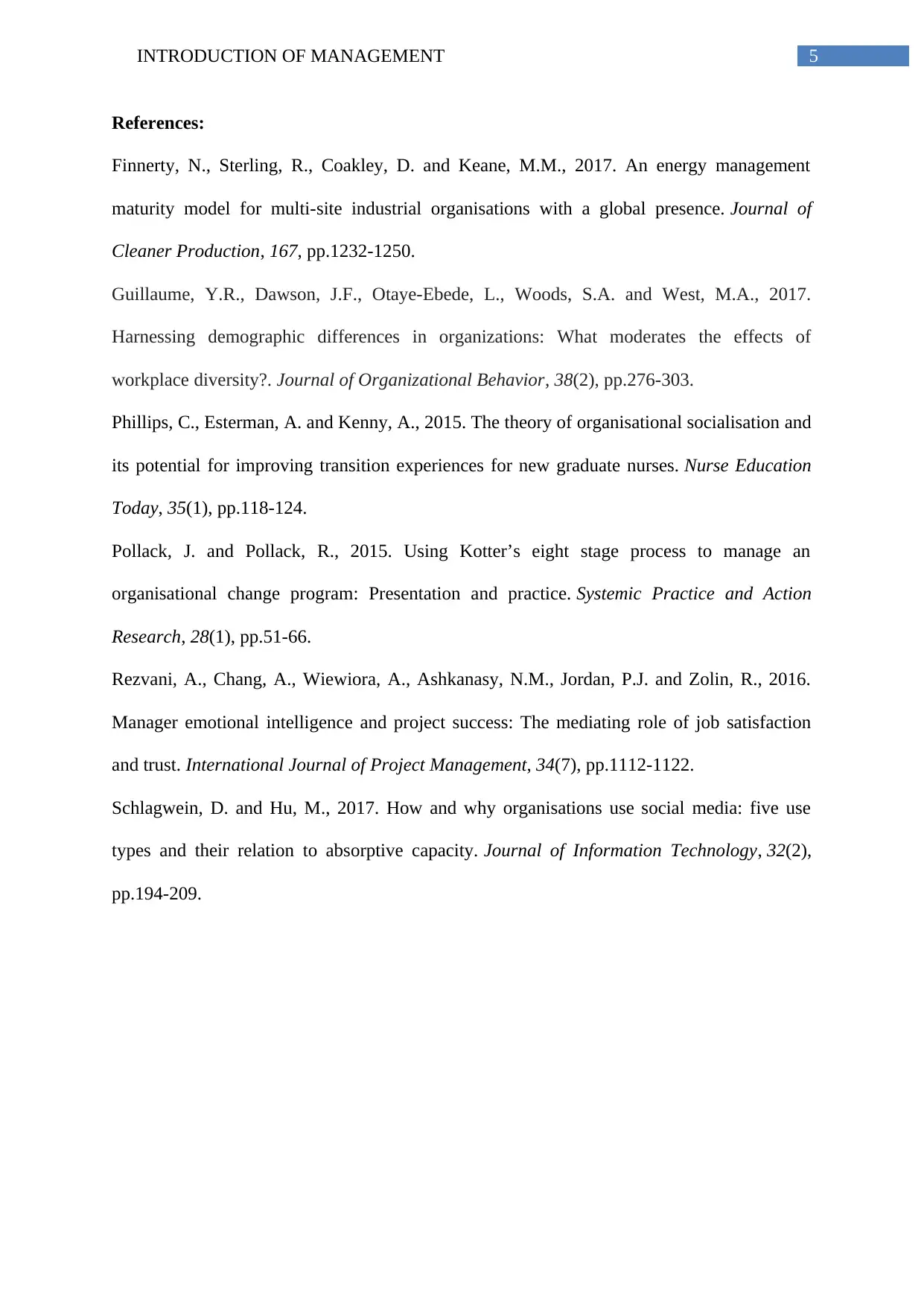
5INTRODUCTION OF MANAGEMENT
References:
Finnerty, N., Sterling, R., Coakley, D. and Keane, M.M., 2017. An energy management
maturity model for multi-site industrial organisations with a global presence. Journal of
Cleaner Production, 167, pp.1232-1250.
Guillaume, Y.R., Dawson, J.F., Otaye‐Ebede, L., Woods, S.A. and West, M.A., 2017.
Harnessing demographic differences in organizations: What moderates the effects of
workplace diversity?. Journal of Organizational Behavior, 38(2), pp.276-303.
Phillips, C., Esterman, A. and Kenny, A., 2015. The theory of organisational socialisation and
its potential for improving transition experiences for new graduate nurses. Nurse Education
Today, 35(1), pp.118-124.
Pollack, J. and Pollack, R., 2015. Using Kotter’s eight stage process to manage an
organisational change program: Presentation and practice. Systemic Practice and Action
Research, 28(1), pp.51-66.
Rezvani, A., Chang, A., Wiewiora, A., Ashkanasy, N.M., Jordan, P.J. and Zolin, R., 2016.
Manager emotional intelligence and project success: The mediating role of job satisfaction
and trust. International Journal of Project Management, 34(7), pp.1112-1122.
Schlagwein, D. and Hu, M., 2017. How and why organisations use social media: five use
types and their relation to absorptive capacity. Journal of Information Technology, 32(2),
pp.194-209.
References:
Finnerty, N., Sterling, R., Coakley, D. and Keane, M.M., 2017. An energy management
maturity model for multi-site industrial organisations with a global presence. Journal of
Cleaner Production, 167, pp.1232-1250.
Guillaume, Y.R., Dawson, J.F., Otaye‐Ebede, L., Woods, S.A. and West, M.A., 2017.
Harnessing demographic differences in organizations: What moderates the effects of
workplace diversity?. Journal of Organizational Behavior, 38(2), pp.276-303.
Phillips, C., Esterman, A. and Kenny, A., 2015. The theory of organisational socialisation and
its potential for improving transition experiences for new graduate nurses. Nurse Education
Today, 35(1), pp.118-124.
Pollack, J. and Pollack, R., 2015. Using Kotter’s eight stage process to manage an
organisational change program: Presentation and practice. Systemic Practice and Action
Research, 28(1), pp.51-66.
Rezvani, A., Chang, A., Wiewiora, A., Ashkanasy, N.M., Jordan, P.J. and Zolin, R., 2016.
Manager emotional intelligence and project success: The mediating role of job satisfaction
and trust. International Journal of Project Management, 34(7), pp.1112-1122.
Schlagwein, D. and Hu, M., 2017. How and why organisations use social media: five use
types and their relation to absorptive capacity. Journal of Information Technology, 32(2),
pp.194-209.
1 out of 6
Related Documents
Your All-in-One AI-Powered Toolkit for Academic Success.
+13062052269
info@desklib.com
Available 24*7 on WhatsApp / Email
![[object Object]](/_next/static/media/star-bottom.7253800d.svg)
Unlock your academic potential
© 2024 | Zucol Services PVT LTD | All rights reserved.





